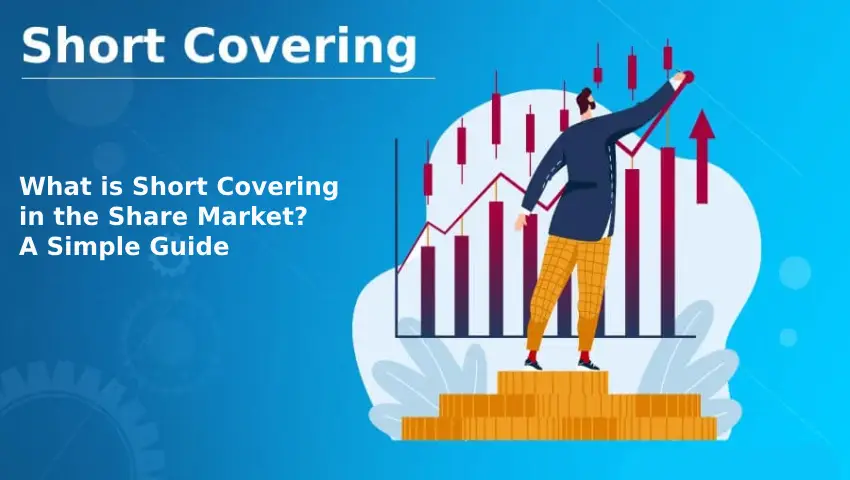
- 07/05/2025
- MyFinanceGyan
- 582 Views
- 1 Likes
- Share Market
What is Short Covering in the Share Market? – A Simple Guide
The share market is a busy place where people buy and sell shares to make money. There are many terms used here, and one important term is short covering. Knowing about short covering is important because it can cause big changes in share prices and give traders good opportunities to earn profits.
In this blog, we will explain short covering in an easy way, how it works, why it matters, and some real examples to help you understand it clearly.
What is Short Selling?
Before we talk about short covering, you need to know what short selling is. Short selling means selling shares that you don’t actually own, hoping to buy them back later at a lower price.
Here’s how it works:
- You borrow shares from a broker and sell them in the market.
- If the price of the shares drops, you buy them back at the lower price.
- You return the shares to the broker and keep the difference as profit.
Example:
Suppose Company X’s share is trading at ₹500. You believe the price will fall, so you borrow and sell 100 shares. If the price drops to ₹400, you buy back the shares, return them, and make a profit of ₹100 per share.
What is Short Covering?
Short covering happens when a trader who sold shares earlier (short seller) buys back those shares to close the deal.
Why does short covering happen?
- To Cut Losses: If the stock price goes up instead of falling, the trader buys back quickly to avoid more loss.
- To Book Profits: If the price drops as expected, the trader buys back to take profits.
- Change in Market Mood: Good news or positive changes in the market can make traders cover their shorts.
Simply put, short covering is the action of buying shares to end a short sell.
How Short Covering Affects Share Prices?
When many traders start buying back shares at the same time, it increases demand, which can push the share price higher. Sometimes, the price rises very quickly and sharply. This is called a short squeeze.
Short Squeeze:
When a stock that many people have shorted suddenly starts rising, short sellers panic and rush to buy shares. This rush pushes the price even higher, creating a cycle of more and more buying.
Real-Life Example:
In India, stocks like Adani Enterprises and Vodafone Idea have seen sudden strong rallies (sharp price rises) because of short covering during important news announcements or changes in rules.
How to Spot Short Covering?
Finding short covering is not always easy, but there are some signs:
- High Trading Volumes: If more shares are traded than usual along with a price rise, it might be due to short covering.
- Open Interest Drops: In futures and options trading, if the open interest falls while the price rises, it can be a sign of short covering.
- Technical Charts: Some patterns and momentum indicators can hint at a short squeeze.
- News and Events: Positive news, good results, or regulatory changes can trigger short covering.
Short Covering vs Fresh Buying:
Both short covering and fresh buying involve buying shares, but they are different:
- Short Covering: Buying shares to close an earlier short sell.
- Fresh Buying: Buying shares because you believe prices will rise.
Why it matters:
If a rally is mainly due to short covering, it might not last long.
If a rally is due to fresh buying, it is usually stronger and can continue longer.
Risks Involved in Short Covering:
Short covering can be risky:
- Market Becomes Volatile: Prices can move up and down very fast.
- Liquidity Problems: In stocks with less trading, it can be hard to buy back shares at a good price.
- Emotional Decisions: Fear of losses can lead to wrong and quick decisions.
- Rules and Regulations: SEBI (India’s market regulator) has rules for short selling that can affect trades.
Strategies That Use Short Covering:
Experienced traders use short covering in different ways:
- Pair Trading: Buying one stock and shorting another similar stock. If needed, they cover their short.
- Hedging: Short selling to protect (hedge) against possible losses in other investments.
- Event-Based Trading: Shorting before important events like earnings reports, and covering after results come out.
Impact on Market Sentiment:
Short covering can make the market look bullish (positive) for a short time. However, traders need to be careful — not every rally caused by short covering is backed by strong fundamentals.
Rules for Short Selling in India:
In India, SEBI controls short selling:
- Only certain stocks (those in Futures & Options) can be shorted.
- Traders must maintain a margin (security money) with brokers.
- Big investors must report their short positions.
- SEBI can ban short selling in a stock if it crosses certain limits.
These rules keep the market fair and protect small investors.
Short Covering in Bear and Bull Markets:
Short covering behaves differently in different markets:
- Bear Market (falling market): Short covering happens more often because people are betting on falling prices.
- Bull Market (rising market): Short covering happens when traders wrongly expect prices to fall but they rise instead.
Psychological Pressure in Short Covering:
Short selling is stressful because your possible losses are unlimited (since a stock’s price can rise infinitely). This pressure often causes traders to quickly buy back shares, even if it means booking a loss.
Tips for Retail Traders About Short Covering:
- Stay Updated: Follow important news and market updates.
- Use Stop Loss: Always set a stop loss to limit your losses.
- Be Careful with Borrowed Money: Leverage can be dangerous if not used wisely.
- Watch Volume and Open Interest: These can give hints about short covering.
- Don’t Chase the Rally: If a price rise is only because of short covering, it might not last.
Conclusion:
Short covering is an important part of how the share market works. It can cause quick price changes and affect your trading decisions. By learning to recognize short covering, you can make smarter moves in the market. Whether you are a beginner or an expert, knowing how short covering works will help you handle risk better and find new opportunities.
In the fast-changing world of the stock market, staying informed, thinking clearly, and watching important signals like short covering can help you succeed.
Note: This article is for education only. It is not financial advice or a recommendation to buy or sell any particular stock.



